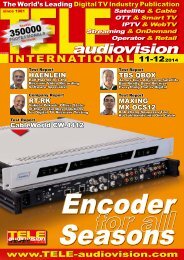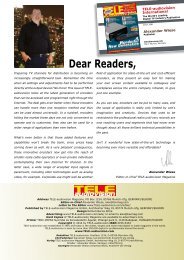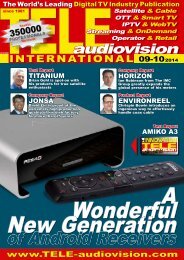ATSC 2.0
You also want an ePaper? Increase the reach of your titles
YUMPU automatically turns print PDFs into web optimized ePapers that Google loves.
FEATURE<br />
Digital Terrestrial TV - 2nd Level<br />
<strong>ATSC</strong> <strong>2.0</strong><br />
• combines various separate norms<br />
and standards into one single suite<br />
• puts all the existing tv viewing<br />
features available nowadays into<br />
one set<br />
• merges all variations into one<br />
• enables superior video and audio<br />
quality<br />
• new standard will replace current<br />
one eventually<br />
170 TELE-audiovision International — The World‘s Largest Digital TV Trade Magazine — 01-02/2013 — www.TELE-audiovision.com www.TELE-audiovision.com — 01-02/2013 — TELE-audiovision International — 全球发行量最大的数字电视杂志 171
FEATURE<br />
Digital Terrestrial TV - 2nd Level<br />
A Marriage of Broadcast TV with<br />
the Internet and Mobile Devices<br />
Jacek Pawlowski<br />
Nowadays all TV is digital, but with<br />
different standards in different regions.<br />
In North America, the first standards<br />
for digital terrestrial TV were published<br />
in the 1990s. Since then, these standards<br />
have been updated a few times<br />
and their recent versions are from<br />
2009, 2010 or 2011. The set of standards<br />
that we usually refer to as “<strong>ATSC</strong>”<br />
actually consists of several tens of harmonized<br />
norms. The most fundamental<br />
one is “A/53: <strong>ATSC</strong> Digital Television<br />
Standard”. You can find the list of all<br />
currently published A/xx standards on<br />
the <strong>ATSC</strong> web site: www.atsc.org.<br />
However, advances in technology<br />
are so fast and the end user requirements<br />
change that quickly that a moment<br />
comes when the standardization<br />
body (in this case <strong>ATSC</strong>) comes to the<br />
conclusion that it is better to establish<br />
a new set of standards rather than introduce<br />
small enhancements in the current<br />
norms. There are simply too many<br />
new things to be covered.<br />
A new set of standards by <strong>ATSC</strong> is<br />
now being released. This new suite is<br />
called simply <strong>ATSC</strong> <strong>2.0</strong>. We will focus in<br />
a moment on the novelties that are to<br />
be covered by <strong>ATSC</strong> <strong>2.0</strong> but please note<br />
that that does not mean that all the<br />
present standards will be thrown out.<br />
<strong>ATSC</strong> <strong>2.0</strong> will use some of the features<br />
that are already present in <strong>ATSC</strong> 1.0<br />
but are not normative but optional. For<br />
example: Advanced video codecs A/72<br />
and A/73, Software download A/97 or<br />
Conditional access A/70. Why is a new<br />
standard needed? The simple answer<br />
is: because the traditional simple linear<br />
broadcasting model “one-to-many”<br />
becomes more and more obsolete today.<br />
Although it is still the most effective<br />
in moving the common content to<br />
very large numbers of viewers, there<br />
are too many alternatives that attract<br />
the end user‘s attention. Today‘s customer<br />
wants to watch what they want<br />
and when they want. They require the<br />
technology to be as flexible as possible.<br />
How many times you felt an impulse<br />
to check something on the Internet<br />
when watching TV? How old is this<br />
actor? In what film did I see him before?<br />
Are you among those ones who<br />
watch TV and surf Internet or chat with<br />
friends at the same time? If so, imagine<br />
a system that in parallel to the normal<br />
news coverage or political discussions,<br />
sends additional data that you<br />
might be interested in to your mobile<br />
device (smartphone/tablet). You are offered<br />
the links you can click to to dig<br />
into more details on what is currently<br />
presented on your flat screen TV. It is<br />
sometimes called “Tell me more” service.<br />
Such extended information will be<br />
downloaded from the broadcaster‘s site<br />
on the Internet and displayed either on<br />
your smartphone, Wi-Fi connected tablet/laptop<br />
or on your TV-screen if you<br />
prefer to.<br />
So now assume that a <strong>ATSC</strong> <strong>2.0</strong> enabled<br />
TV-set is by matterr of course<br />
connected to the Internet – this is in<br />
fact one of the very basic assumptions<br />
of the new system. But the additional<br />
content you might be interested in will<br />
not necessarily be downloaded from<br />
the Internet after you demand it. The<br />
TV-set will be equipped with a storage<br />
device (HDD, or flash memory) and the<br />
broadcaster can send some content<br />
before you might think of downloading<br />
it. Imagine that you are interested in a<br />
new movie just advertised on TV. Your<br />
clever provider has already sent it to<br />
the HDD of your TV-set. A new movie<br />
is just a click away from you. Can you<br />
resist it?<br />
Who knows, maybe a future premium<br />
movie channel will consist of the<br />
stream of advertisements offering you<br />
movies to watch but not actually broadcasting<br />
them at a fixed schedule. It will<br />
be completely up to you what to watch<br />
and when to watch. And because the<br />
Internet connection is a two-way communication,<br />
after some time the system<br />
will “learn” what kind of movies you like<br />
172 TELE-audiovision International — The World‘s Largest Digital TV Trade Magazine — 01-02/2013 — www.TELE-audiovision.com<br />
most and even the advertising will be<br />
adjusted to your preferences. Sounds<br />
a bit terrifying but it already works this<br />
way on the Internet.<br />
But the new <strong>ATSC</strong> <strong>2.0</strong> standard is not<br />
only about integrating TV broadcasts<br />
and the Internet. Why not watch a content<br />
stored on your phone on a large<br />
TV screen? It will not be a problem with<br />
the new standard. And the other way<br />
around: your smartphone will be able<br />
to act as a secondary screen providing<br />
supplemental information to the currently<br />
transmitted video and audio. It<br />
can also be used for other purposes like<br />
voting, buying and so on.<br />
We focused so far on the ways of<br />
watching TV but there are also exciting<br />
technical improvements like: advanced<br />
video compression allowing transmitting<br />
even 1080P/60 Hz video over a 6<br />
MHz channel (MPEG4), advanced audio<br />
codecs, reception of <strong>ATSC</strong> M/H content<br />
(normally dedicated for mobile devices)<br />
on a fixed receiver, 3D television and<br />
advanced interactive services.<br />
You might say that all these things<br />
are already implemented here and<br />
there but remember that when proprietary<br />
solutions get standardized, more<br />
and more producers start to implement<br />
them in their products. You do not have<br />
to reinvent the wheel or pay a fortune<br />
to the original pioneer. When the standards<br />
are out, the new features become<br />
popular and affordable for a wide public.<br />
Today‘s modern digital TV receivers<br />
already combine TV channels delivered<br />
in various ways: satellite, cable, terrestrial,<br />
Internet. The normal user does<br />
not even know, or care, what the transmission<br />
media is. However, there is<br />
no significant integration between the<br />
world of digital TV and many services<br />
typical for the Internet domain. <strong>ATSC</strong><br />
<strong>2.0</strong> is a significant step toward combining<br />
these two worlds.


















